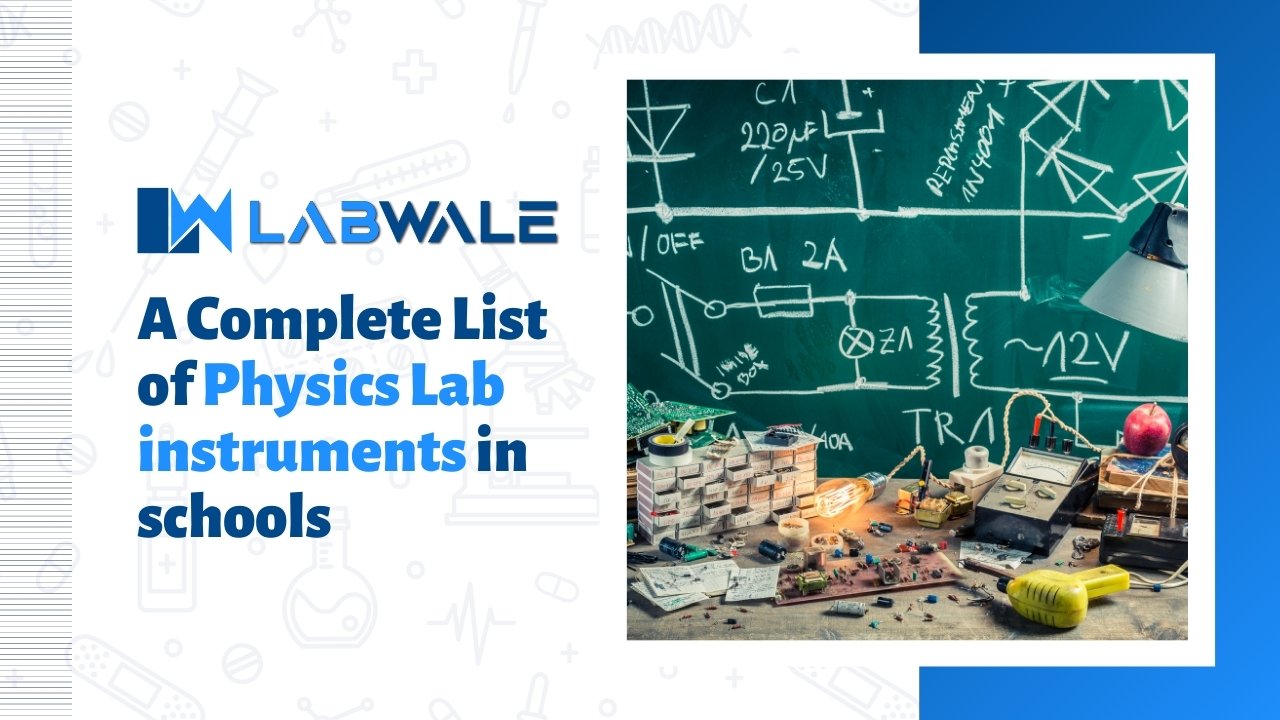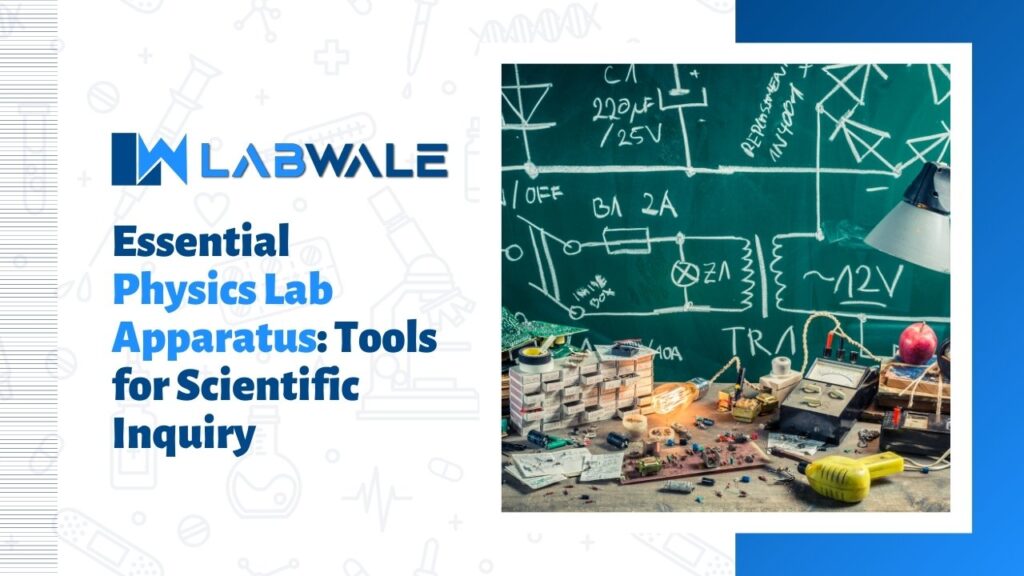-
-
 Cardiology
Cardiology
-
 Clinical Oncology
Clinical Oncology
-
 Dental
Dental
-
 Dermatology
Dermatology
-
 Ear, Nose, Throat (ENT)
Ear, Nose, Throat (ENT)
-
 Endocrinology
Endocrinology
-
 Gastroenterology
Gastroenterology
-
 General Surgery
General Surgery
-
 Gynecology & Obstetrics
Gynecology & Obstetrics
-
 Interventional Cardiology
Interventional Cardiology
-
 Nephrology
Nephrology
-
 Neurology
Neurology
-
 Oncology Surgery
Oncology Surgery
-
 Ophthalmology
Ophthalmology
-
 Orthopedics
Orthopedics
-
 Pediatrics
Pediatrics
-
 Pediatrics Surgery
Pediatrics Surgery
-
 Physiotherapy
Physiotherapy
-
 Plastic Surgery
Plastic Surgery
-
 Psychiatry & Psychology
Psychiatry & Psychology
-
 Radiology
Radiology
-
 Urology
Urology
-
 Vascular Surgery
Vascular Surgery
-
A Complete List of Physics Lab Instruments in schools

Contents
Physics is a natural science that studies matter and its motion as well as how they interact. It is considered one of the most fundamental scientific disciplines. The main goal of physics is to explain how the universe behaves. Physics also involves studying the structure of matter, energy, time, and space.
To conduct physics experiments, you need specific physics lab instruments. In this blog article, we will provide a complete list of physics lab instruments that are commonly used in schools.
List of Physics Lab Instruments
As a physics student, you will be expected to have a strong understanding of the various physics lab instruments. This list will help you identify the most common lab equipment and understand their purposes.
1. Vernier Caliper
A vernier caliper is one of the physics lab instruments used to measure the internal or external dimensions of an object. It consists of two scales, one fixed and one movable, that are calibrated to provide a precise measurement.
The vernier caliper is a precision measuring tool that is used in many physics laboratories. It is a one of the versatile physics lab instruments that can be used to measure a wide variety of objects.
2. Micrometer Screw Gauge
As a physics student, you will likely use a micrometer screw gauge at some point in your studies. This one of the simple physical lab instruments is used to measure small distances, and is composed of two main parts: the thimble and the anvil.
The thimble is attached to a screw, which is used to turn the thimble and move the anvil closer or further away from it. There are markings on the thimble that indicate how much it has been turned, so that precise measurements can be taken.
To use the micrometer screw gauge, simply place the object you wish to measure between the anvil and the thimble. Turn the screw until the anvil is touching the object, then read the measurement on the thimble. For example, if the thimble reads 2.5 cm, this means that the object being measured is 2.5 cm long.
The micrometer screw gauge is a useful tool for taking precise measurements, and is an essential piece in physics lab instruments.
3. Measuring Tape
A ruler is the most basic tool in any physics lab instruments, and a measuring tape is an essential part of any ruler. Measuring tapes come in various sizes, but most school physics labs will have a standard size of about 30 cm.
A measuring tape can be used to measure the length of an object, the width of an object, or the thickness of an object. It can also be used to measure the circumference of an object.
4. Bar Magnets
Bar magnets are one of the most common physics lab instruments found in schools. They are used to demonstrate the principles of magnetism and can be used in a variety of experiments.
One popular experiment is to measure the magnetic field strength of a bar magnet. This can be done by placing the magnet on a balance and measuring the force it exerts on another magnetic object.
Another common experiment is to use bar magnets to levitate small objects. This is done by suspending the magnet from a string and then placing the object on top of it. The object will be attracted to the magnet and will float in the air.
Bar magnets can also be used to create electric currents. This is done by passing a current through a coil of wire that is wrapped around the magnet. The magnetic field will cause the electrons in the wire to flow and create an electric current.
Bar magnets are a versatile tool that can be used to teach a variety of physics concepts. They are an essential part of any physics lab instruments and are sure to provide hours of fun and learning!
5. Iron Fillings
Iron is a common element in the universe, and it has been used by humans for centuries. Iron is strong and durable, making it an ideal material for many applications. In the field of physics, iron is used in a variety of ways.
One common use of iron in physics is in ferromagnetism. Ferromagnetism is the basis for technologies like magnetic resonance imaging (MRI) and magnetic data storage. Iron is also used in electromagnetism, where it is used to make electromagnets.
In addition to its use in magnetism, iron is also used in thermodynamics and mechanics. For example, iron is often used as a material for constructing steam boilers. The high melting point of iron makes it useful for creating alloys with other metals.
Iron fillings are a common material includes in list of school physics lab instruments. They are cheap and easy to obtain, making them perfect for use in experiments.
6. Lenses
Lenses are one of the most important in physics lab instruments. They allow us to focus light and magnify objects. Lenses are used in a variety of physics experiments, from studying the properties of light to investigating the behavior of particles.
There are many different types of lenses, including concave lenses, which make objects appear smaller, and convex lenses, which make them appear larger. Lenses can also be made from a variety of materials, including glass and plastic.
No matter what type of lens you need, you’re sure to find it on this complete list of physics lab instruments!
7. Prism
A prism is a transparent optical element with flat, polished surfaces that refract light. Prisms are used in optical physics lab instruments to disperse light and create spectra. They can also be used to reflect light or to direct light through a beam path.
Prisms are named for their geometric shape; the most common type is the triangular prism. Other types of prisms include the rectangular prism, the pentagonal prism, and the hexagonal prism. The size and shape of a prism determine its dispersive power, which is the ability to spread out light into its component colors (the spectral colors).
Prism glasses are often used in spectroscopes and binoculars. A right-angle prism can be used to reflect light at a 90-degree angle, while a dovetail prism can split a beam of light into two separate beams.
8. Magnifier Tripod
The list of physics lab instruments are incomplete without a magnifier tripod. This one of the essential physics lab instrument used to enlarge objects so that they can be studied more closely. It is an important tool for investigating the world around us.
A magnifier tripod is a three-legged stand that supports a magnifying glass. The glass is usually attached to the tripod with a clamp. Magnifier tripods are also known as optical benches.
Most magnifier tripods have adjustable legs so that they can be set up on uneven surfaces. They also have a platform on which objects can be placed. This makes it easier to examine small objects. Magnifier tripods are available in different sizes and styles. Some have a single magnifying glass while others have multiple glasses. The size of the glass varies from small to large.
9. Laboratory Spherometer
A laboratory spherometer is one of the physics lab instruments used to measure the curvature of lenses and other curved surfaces. It consists of a needle, a glass plate, and a measuring scale. The needle is placed on the glass plate and the surface to be measured is placed under the glass plate. The reading on the scale is then used to calculate the curvature of the surface.
Laboratory spherometers are used in physics labs to measure the curvature of lenses and other curved surfaces. They are essential for experiments involving optics and light. Without a laboratory spherometer, it would be very difficult to accurately measure the curvature of lenses and other curved surfaces.
If you are setting up physics lab instruments, make sure to include a laboratory spherometer on your list of equipment. It is an essential tool for many experiments.
10. Helical Spring
A helical spring is a type of spring that is typically included in physics labs instruments. It is made of a coil of metal that is wrapped around a central rod. The coils are typically made of steel, but can also be made of other materials such as copper or brass.
Helical springs are used to create a force that can be applied to an object. They are often used in experiments to measure the effects of gravity on an object.
11. Large Pulley Demonstration Set
In a high school physics lab instruments, students can learn about the basics of mechanical advantage with a large pulley demonstration set. This type of equipment is commonly used to demonstrate how a machine can reduce the amount of force needed to lift an object.
With this set, students can see how the size and number of pulleys affects the amount of force required to lift a load.
Conclusion
This concludes our list of physics lab instruments that are commonly found in schools. While this is not an exhaustive list, it does cover the most essential pieces of equipment that students will need to carry out their experiments successfully.
This is a complete list of physics lab instruments that are commonly used in schools. We hope that this article has been helpful in providing you with a better understanding of the different types of instruments that are available and how they can be used in physics labs.


 Anatomy Lab Equipments
Anatomy Lab Equipments
 Biochemistry Lab Equipments
Biochemistry Lab Equipments
 Biology Lab Equipments
Biology Lab Equipments
 Chemistry Lab Equipments
Chemistry Lab Equipments
 Cytology Lab Equipments
Cytology Lab Equipments
 Cytopathology Lab Equipments
Cytopathology Lab Equipments
 Dental Lab Equipments
Dental Lab Equipments
 Forensic Lab Equipments
Forensic Lab Equipments
 Genetics Lab Equipments
Genetics Lab Equipments
 Hematology Lab Equipments
Hematology Lab Equipments
 Histology Lab Equipments
Histology Lab Equipments
 Histopathology Lab Equipments
Histopathology Lab Equipments
 Mathematics Lab Equipments
Mathematics Lab Equipments
 Microbiology Lab Equipments
Microbiology Lab Equipments
 Molecular Biology Lab Equipments
Molecular Biology Lab Equipments
 Pathology Lab Equipments
Pathology Lab Equipments
 Pharmaceutical Lab Equipments
Pharmaceutical Lab Equipments
 Physics Lab Equipments
Physics Lab Equipments
 Radiology Lab Equipments
Radiology Lab Equipments
 Science Lab Kit’s
Science Lab Kit’s
 Toxicology Lab Equipments
Toxicology Lab Equipments

 Borosilicate Glass Beaker
Borosilicate Glass Beaker
 Plastic Beaker (Euro Design)
Plastic Beaker (Euro Design)
 Plastic Beaker (Printed Graduation)
Plastic Beaker (Printed Graduation)
 Test Tube Brush
Test Tube Brush
 Measuring Cylinder Brush
Measuring Cylinder Brush
 Conical Flask Brush
Conical Flask Brush
 Volumetric Flask Brush
Volumetric Flask Brush
 Round Bottom Flask Brush
Round Bottom Flask Brush
 Glass Beaker Brush
Glass Beaker Brush
 Pipette Brush
Pipette Brush
 Wash Bottle Brush
Wash Bottle Brush
 Borosilicate Büchner Flask
Borosilicate Büchner Flask
 Borosilicate Erlenmeyer/Conical Flask
Borosilicate Erlenmeyer/Conical Flask
 Borosilicate Pear-Shaped Flask
Borosilicate Pear-Shaped Flask
 Borosilicate Round Bottom Flask
Borosilicate Round Bottom Flask
 Plastic Conical Flask
Plastic Conical Flask
 Plastic Volumetric Flask
Plastic Volumetric Flask
 Bunsen Burner
Bunsen Burner
 Spirit Lamp
Spirit Lamp
 Borosilicate Glass Burette
Borosilicate Glass Burette
 Plastic Burette
Plastic Burette
 Capillary Tube
Capillary Tube
 Centrifuge Tube
Centrifuge Tube
 Test Tube
Test Tube
 Ria Vial
Ria Vial
 Vacutainer Tubes
Vacutainer Tubes
 Syringes
Syringes
 Student Microscope
Student Microscope
 Binocular Microscope
Binocular Microscope
 Dissecting Microscope
Dissecting Microscope
 Microscope Glass Slides
Microscope Glass Slides
 Cover Slip
Cover Slip
 Inoculating Loop
Inoculating Loop
 Slide Box
Slide Box
 Lamps
Lamps
 Oils
Oils
 Beaker Tongs
Beaker Tongs
 Crucible Tongs
Crucible Tongs
 Flask Tongs
Flask Tongs
 Borosilicate Glass Funnel
Borosilicate Glass Funnel
 Plastic Funnels
Plastic Funnels
 Wash Bottle
Wash Bottle
 Borosilicate Glass Reagent Bottle
Borosilicate Glass Reagent Bottle
 Plastic Reagent Bottle
Plastic Reagent Bottle
 Borosilicate Measuring Cylinder
Borosilicate Measuring Cylinder
 Plastic Measuring Cylinder
Plastic Measuring Cylinder
 Borosilicate Glass Graduated Pipette
Borosilicate Glass Graduated Pipette
 Borosilicate Glass Volumetric Pipette
Borosilicate Glass Volumetric Pipette
 HB Pipette
HB Pipette
 Pasteur Pipette
Pasteur Pipette
 Micropipettes
Micropipettes
 Micropipette Tips
Micropipette Tips
 Filter Paper
Filter Paper
 Litmus Paper
Litmus Paper
 pH Paper
pH Paper
 Chromatography Paper
Chromatography Paper
 Plastic Petri Plates (Sterile)
Plastic Petri Plates (Sterile)
 Glass Petri Plates (Non-Sterile)
Glass Petri Plates (Non-Sterile)
 Safety Goggles
Safety Goggles
 Lab Coats
Lab Coats
 Gloves
Gloves
 Masks
Masks
 Shoe Covers
Shoe Covers
 Hair & Beard Covers
Hair & Beard Covers
 Steel Spatula
Steel Spatula
 Plastic Spatula
Plastic Spatula
 Hitachi Sample Cup
Hitachi Sample Cup
 Plastic Scoop
Plastic Scoop
 Plastic Medicine Cup
Plastic Medicine Cup
 Dissecting Tool Kit
Dissecting Tool Kit
 Dissecting Forceps
Dissecting Forceps
 Hemostatic Forceps
Hemostatic Forceps
 Thumb Forceps / Tweezers
Thumb Forceps / Tweezers
 Blood Culture Bottle
Blood Culture Bottle
 Urine Container
Urine Container
 Wooden Swab Stick
Wooden Swab Stick
 Test Tube Holder
Test Tube Holder
 Test Tube Racks
Test Tube Racks
 Magnifying Glass
Magnifying Glass
 Watch Glass
Watch Glass
 Mortar and Pestle
Mortar and Pestle
 Coplin Jar
Coplin Jar
 Plastic Stirrer
Plastic Stirrer
 Glass Stirrer
Glass Stirrer
 Crucible
Crucible
 Tripod
Tripod
 Wire Mesh
Wire Mesh
 Laboratory Thermometer
Laboratory Thermometer
 Tourniquet
Tourniquet
 Alcohol Swab
Alcohol Swab
 Blood Lancet
Blood Lancet
 Bandage
Bandage
 Gloves & Masks
Gloves & Masks









 Cardiology
Cardiology Clinical Oncology
Clinical Oncology






